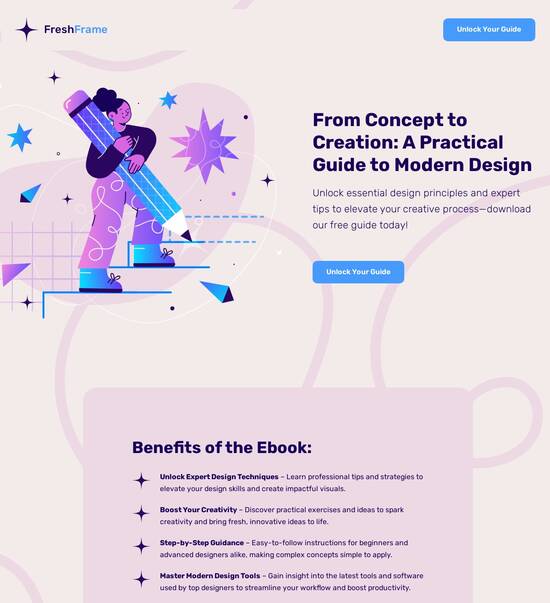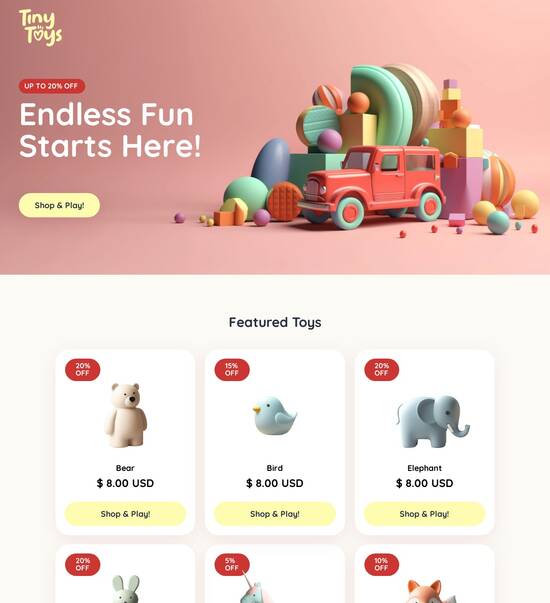
Travel blog template compatible with PrestaShop
Explore Similar TemplatesAbout template
Streamline your content management with travel blog templates designed for compatibility with PrestaShop.
Recommended templates

Easy to build without coding
With the intuitive drag-and-drop builder, anyone on your team can create high-converting pages without any knowledge of code or design. Make enhancements to your landing page with custom widgets using Javascript, HTML/CSS, or third-party scripts.

Multiple layouts for any industry and goal
Select from 500+ landing page layouts built to boost conversions across industry-specific scenarios. Customize them by adjusting fonts, adding images, and generating on-brand content with the AI assistant. Quickly scale with Instablocks® and Global Blocks that you can save, reuse, and update globally.

Loads fast and looks polished on any device
Every template is responsive, which means they present professionally on any device and load blazingly fast with our Thor Render Engine. You can also power them up with Google AMP technology to deliver an unparalleled mobile experience and drive higher conversions.

Robust analytics & experimentation
Get real-time updates and reporting across all your devices, showing the number of visitors, conversions, cost-per-visitor, and cost-per-lead. Launch AI-powered experiments, run A/B tests, and use heatmaps to analyze user behavior, then optimize your landing page to maximize conversions.







Easy to build without coding
With the intuitive drag-and-drop builder, anyone on your team can create high-converting pages without any knowledge of code or design. Make enhancements to your landing page with custom widgets using Javascript, HTML/CSS, or third-party scripts.
Multiple layouts for any industry and goal
Select from 500+ landing page layouts built to boost conversions across industry-specific scenarios. Customize them by adjusting fonts, adding images, and generating on-brand content with the AI assistant. Quickly scale with Instablocks® and Global Blocks that you can save, reuse, and update globally.
Loads fast and looks polished on any device
Every template is responsive, which means they present professionally on any device and load blazingly fast with our Thor Render Engine.
Robust analytics & experimentation
Get real-time updates and reporting across all your devices, showing the number of visitors, conversions, cost-per-visitor, and cost-per-lead. Launch AI-powered experiments, run A/B tests, and use heatmaps to analyze user behavior, then optimize your landing page to maximize conversions.
All the features you need to build lead-generating landing pages
Explore more featuresLearn how to build top-performing landing pages for any goal
FAQs
Leading the way in building high-performing landing pages





A complete guide to leveraging Instapage for effective landing page creation and CRO
Instapage is a powerful platform that transforms digital marketing campaigns through optimized landing pages and conversion rate optimization techniques. For marketers in the USA, especially in sectors like Business Services, Tech/SaaS, and Financial Services, mastering landing pages is critical to maximizing ROI and achieving campaign goals.
Understanding the power of landing pages
Landing pages serve as a vital touchpoint between your brand and potential customers. A well-crafted landing page guides visitors towards taking specific actions, such as signing up or purchasing a service. In the marketing landscape, it’s imperative to understand how key elements drive engagement and conversions, especially when executed through Instapage's versatile features.
- High-converting templates: Instapage offers over 100 professionally designed templates, tailored for various verticals. These templates are optimized for mobile and desktop views, ensuring broad accessibility.
- Dynamic content personalization: Through features like dynamic text replacement and AdMaps, marketers can tailor experiences for specific audiences, vastly improving engagement rates.
- Robust analytics tools: With detailed heatmaps and an analytics dashboard, users can assess on-page behavior and optimize their landing pages based on actual user interaction.
Creating your first landing page
Launching a landing page on Instapage is intuitive and requires no coding skills. Follow these steps to create a high-performing page tailored to your audience:
- Choose a template: Select a template from the extensive library that aligns with your campaign goals.
- Customize with the editor: Use Instapage's drag-and-drop editor to modify elements like images, text, and buttons to match your brand identity.
- Integrate lead generation elements: Add forms and CTA buttons that capture leads effectively, optimizing them for conversion through strategic placement.
Optimizing for conversions
To ensure your landing page drives the desired results, it’s important to regularly assess and optimize its performance. Consider these advanced features:
- A/B testing: Instapage allows you to create variations of your landing page to test different headlines, images, and CTAs, ensuring you find the best-performing elements.
- Utilizing heatmaps: By viewing where users click most frequently, you can optimize your page layout and element placement based on actual data.
- Audience targeting: Leverage data tools to track audience engagement, allowing for tailored follow-ups and personalized experiences to increase conversion rates.
By utilizing Instapage’s features, marketers can create impactful landing pages that not only attract visitors but also convert them into leads or sales. The combination of high-quality, customizable templates and robust optimization tools ensures success in a competitive digital environment.
With Instapage, the path to optimization is streamlined and efficient. Dive in today and start transforming your digital marketing campaigns with powerful landing page strategies.
Explore Instapage now to build your first effective landing page and unlock the full potential of your marketing campaigns!
Travel blog template compatible with PrestaShop
Understanding the essentials of a travel blog template in PrestaShop
PrestaShop is an open-source eCommerce platform that allows businesses to create and manage their online stores with ease. With a range of customizable features and flexibility for various business models, it has gained traction among online retailers seeking to establish a solid web presence. In the context of a travel-related business, utilizing a travel blog template within PrestaShop can significantly enhance the overall effectiveness of the online venture, making it not just a space for transactions but a hub for storytelling and inspiration.
Travel blog templates play a crucial role in the travel business landscape. They facilitate the sharing of captivating travel stories, tips, and experiences, which in turn helps engage visitors and persuade them to explore offered services. A well-designed travel blog template allows businesses to seamlessly integrate their blog with eCommerce functionalities, thus improving brand visibility and visitor interaction.
Importance of a travel blog for travel websites
Travel blogs are invaluable for any travel website aiming to attract and retain visitors. By incorporating storytelling elements, travel blogs enhance visitor engagement. Writing about unique experiences, travel destinations, or personal tips provides visitors with memorable content that keeps them returning for more. Furthermore, this kind of engagement fosters trust and builds community among travel enthusiasts, strengthening the brand's online presence.
In addition to engagement, a travel blog is a powerful tool for driving organic traffic. By focusing on keyword-rich content that encompasses travel themes, businesses can take advantage of various SEO benefits. This not only boosts visibility in search engine results but also establishes the travel blog as an authority in the travel niche, making it more likely that potential customers will choose that brand when booking services.
Key features of an ideal travel blog template
User-friendly interface
A user-friendly interface is fundamental to retaining visitors on your travel blog. A simplified navigation system helps users find the information they need without feeling overwhelmed. The importance of intuitive design elements cannot be overstated; buttons, menus, and links should be easily identifiable, making the website simple to explore.
Customizable design options
A flexible design is key in appealing to various travel niches. The ability to choose from a variety of themes allows business owners to align their website’s look with their brand’s identity. Whether it's a serene beach getaway or a rugged mountain adventure, the right aesthetics can convey the essence of the experiences being offered. Additionally, having the option to switch layouts enables customization based on the type of content shared, which can further enhance visitor engagement.
Mobile responsiveness
In the landscape of eCommerce, a significant percentage of users access websites via mobile devices. With over half of all web traffic coming from mobile users, a mobile-responsive layout is no longer optional but essential. Ensuring that the travel blog is easily viewable and navigable on smartphones and tablets helps maintain visitor interest and reduces bounce rates. A consistent experience across devices improves overall brand perception.
Integrated SEO optimization tools
Effective SEO practices can determine the success of a travel blog. A quality travel blog template should come equipped with integrated SEO optimization tools, giving users the ability to manage keywords and enhance metadata easily. This can include features for optimizing URLs to be more search-engine friendly, allowing the website to rank higher in search results. Overall, this leads to increased visibility and organic traffic.
Key components for setting up your travel blog template
Setting up your travel blog template in PrestaShop is straightforward once you have created an account. Start by signing up on the PrestaShop website. During this process, it's essential to choose a strong password, ensuring that your store remains secure from unauthorized access. Prioritize security measures from the start, as you wouldn't want to compromise the safety of your website later down the line.
After completing account creation, the next step involves registering a new account specifically for your store management. This registration process will guide you through the initial setup, including the selection of your store name and configuration of essential settings. Pay attention to these customization options, as they will affect your travel blog's functionality and aesthetic appeal throughout its operation.
Exploring themes of travel blog templates
When considering a travel blog on PrestaShop, the theme you select plays a pivotal role in how visitors perceive your brand. There are numerous templates specifically designed for travel, each offering unique aesthetics and functionality. Popular choices often include vibrant color schemes that reflect a sense of adventure, typography that is easy to read, and imagery that evokes the thrill of travel.
Importance of visual appeal
Visual appeal cannot be dismissed when it comes to retaining visitors. Striking imagery can significantly enhance user experience and keep individuals exploring your site. Best practices dictate using high-resolution images optimized for web use, ensuring fast loading times. Understanding aspect ratios and appropriate file sizes can make a substantial difference in performance.
Designing for success – optimize your travel website
Designing a travel blog that not only attracts visitors but also keeps them engaged requires strategic planning. Key design elements that contribute to visitor engagement include intuitive placement of call-to-action buttons, engaging content such as travel stories and useful guides, and signup forms for newsletters. The goal is to create content that is not only informative but also compelling and relevant to the audience.
Incorporating shopping cart features is another critical aspect of optimizing a travel blog website. Streamlining the checkout process for travel bookings ensures that customers can easily navigate their purchases, enhancing the overall user experience. Carefully managing bookings versus product sales through the store setup is vital for effective revenue generation while maintaining a focus on customer satisfaction.
Enhancing user experience with functionality
To truly engage visitors, adding interactive features can significantly improve their journey on your website. Implementing tools such as destination maps can help users visualize travel plans, while travel itineraries cater to their needs more effectively. Additionally, creating sections for user-generated content like reviews or testimonials further strengthens your site's credibility and fosters community interaction.
Utilizing analytics to track visitor behavior is equally crucial. PrestaShop includes built-in analytics tools that allow you to monitor how users interact with your site. Understanding visitor journeys not only helps in optimizing the design but also tailors content to better meet their interests, thereby increasing the likelihood of successful conversions.
Driving traffic and building a community
To attract consistent traffic to your travel blog, consider implementing various strategies. Leveraging social media platforms is integral for visibility, allowing you to share travel stories and engage with a broader audience base. Creating specialized email marketing campaigns focused on travel deals and tips also keeps your community informed and engaged.
Building a loyal visitor base hinges on the quality and consistency of updates on your travel blog. Regular content refreshes and engaging newsletters keep visitors returning for the latest offerings. Additionally, creating user-friendly forums or discussion boards encourages community interaction, creating a space where travel enthusiasts can connect and share insights.
Measuring success and continuous improvement
Tracking success involves understanding key performance indicators (KPIs) specific to travel blogs. Metrics such as visitor count, engagement rates, and conversion rates offer insight into the effectiveness of your blog. Regular monitoring enables businesses to identify trends and adjust strategies to optimize performance continually.
Remaining updated on evolving travel trends is crucial for keeping content fresh and relevant. As consumer preferences shift, adapting your travel blog content is essential to align with changing industry topics. Researching popular travel themes and integrating them can significantly elevate the credibility and engagement rates of your online travel platform.
Real-life examples of successful travel blogs on PrestaShop
Observing real-life examples of travel blogs successfully utilizing PrestaShop can offer valuable insights. Case studies of stores that effectively leverage travel blog templates reveal key design choices and content strategies that have resonated well with visitors. These examples can serve as inspiration for your own platform, showcasing how well-executed layouts and engaging narratives can lead to significant user engagement.
Learning from the experiences of established travel bloggers offers actionable insights on overcoming common challenges. Their success stories often include tips on effective content strategies, optimization techniques, and community engagement methods that you can adapt for your travel blog’s journey.
Ready to skyrocket conversions?
Supercharge your ad campaigns with high-performing landing pages
Get started














